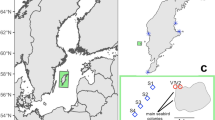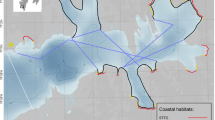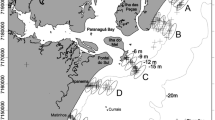Abstract
Sustained strong offshore winds generate upwelling in the fjords of northern South Georgia. Deepwater plankton is “pumped” by upwelling towards sandy beaches at the heads of the fjords; calanoid copepods, chaetognaths and pteropods are stranded by the sand “filter” in large quantities on falling tides. Local benthonic species (harpacticoid copepods and amphipods) are present in the plankton but do not strand. Strandlines are very rich (<4 kg wet mass m-2) and provide large fractions of the food of kelp gulls, sheathbills and terns in the austral summer. Birds can only exploit fresh strandlines, since air-drying of the plankton soon makes it too salty to eat.
Similar content being viewed by others
References
Andrews KJH (1966) The distribution and life-history of Calanoides acutus (Giesbrecht). Discovery' Rep 34: 117–162
Ardley RAB (1936) The birds of the South Orkney Islands. ‘Discovery’ Rep 12: 349–376
Baker AdeC (1954) The circumpolar continuity of Antarctic plankton species. ‘Discovery’ Rep 27: 201–218
Campbell B, Lack E (1985) A dictionary of birds. T & AD Poyser, Calton
Clapperton CM, Sugden DE, Birnie RV, Hansom JD, Thom G (1978) Glacier fluctuations in South Georgia and comparison with other island groups in the Scotia Sea. In: Van Zinderen Bakker EM (ed) Antarctic glacial history and world palaeoen-vironments. AA Balkema, Rotterdam, pp 95–104
Croxall JP, Prince PA (1980) Food, feeding ecology and ecological segregation of seabirds at South Georgia. Biol J Linn Soc 14: 103–131
Croxall JP, Prince PA (1987) Seabirds as predators on marine resources, especially krill, at South Georgia. In: Croxall JP (ed) Seabirds: feeding ecology and role in marine ecosystems. Cambridge University Press, Cambridge, pp 347–368
Davenport J, Others (1995) The marine ecology of the Laguna San Rafael (Southern Chile): ice scour and opportunism. Estuar cstl, Shelf Sci
David PM (1955) The distribution of Sagitta gazellae Ritter-Zahony. ‘Discovery’ Rep 27: 235–278
David PM (1958) The distribution of the chaetognatha of the Southern Ocean. ‘Discovery’ Rep 29: 199–228
Fänge R, Schmidt-Nielsen K, Osaki H (1958) The salt gland of the herring gull. Biol Bull mar biol Lab, Woods Hole 115: 162–171
Furness RW, Monaghan P (1987) Seabird ecology. Blackie, London
Hardy AC, Gunther ER (1935) The plankton of the South Georgia whaling grounds and adjacent waters, 1926–27. ‘Discovery’ Rep 11: 1–456
Headland R (1984) The island of South Georgia. Cambridge University Press, Cambridge
Jones NV (1963) The sheathbill Chionis alba (Gmelin) at Signy Island, South Orkney Islands. Br Antarct Surv Bull 2: 53–71
Lewis Smith RI, Walton DWH (1975) South Georgia, subantarctic. In: Rosswall T, Heal OW (eds) Structure and function of tundra ecosystems. Ecol Bull Stockholm 20: 399–423
Mackintosh NA (1934) Distribution of the macroplankton in the Atlantic sector of the Antarctic. ‘Discovery’ Rep 9: 65–160
Ommanney FD (1936) Rhincalanus gigas (Brady) a copepod of the southern macroplankton. ‘Discovery’ Rep 13: 277–384
Prince PA, Payne MR (1979) Current status of birds at South Georgia. Br Antarct Surv Bull 48: 103–118
Rankin JC, Davenport J (1981) Animal osmoregulation. Blackie & Son Ltd, Glasgow
Tattersall OS (1955) Mysidacea. ‘Discovery’ Rep 1-190
Walker AJM (1972) Introduction to the ecology of the antarctic limpet Patinigera polaris (Hombron and Jacquinot) at Signy Island, South Orkney Islands. Br Antarct Surv Bull 28: 49–69
Woods RW (1988) Guide to the birds of the Falkland Islands. Anthony Nelson Ltd, Oswestry
Young EC (1978) Behavioural ecology of Lönnbergi skuas in relation to environment on the Chatham Islands, New Zealand. NZ J Zool 5: 401–416
Author information
Authors and Affiliations
Additional information
Communicated by J. Mauchline, Oban
Rights and permissions
About this article
Cite this article
Davenport, J. Upwelling-generated plankton strandlines: important predictable food sources for seabirds at Husvik, South Georgia. Marine Biology 123, 207–217 (1995). https://doi.org/10.1007/BF00353612
Received:
Accepted:
Issue Date:
DOI: https://doi.org/10.1007/BF00353612




